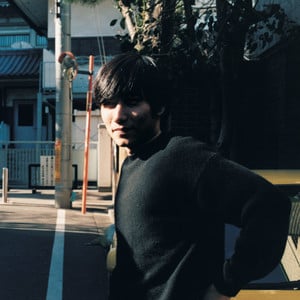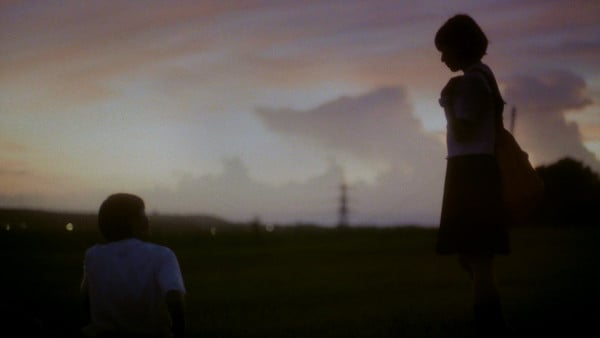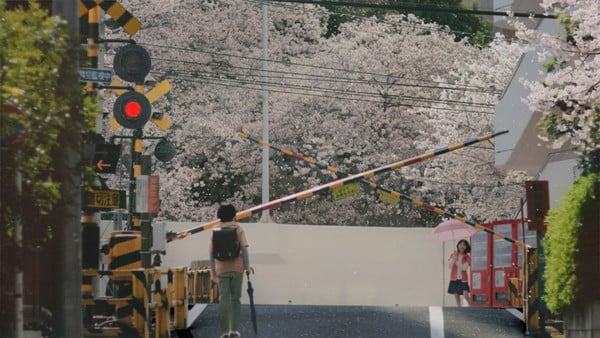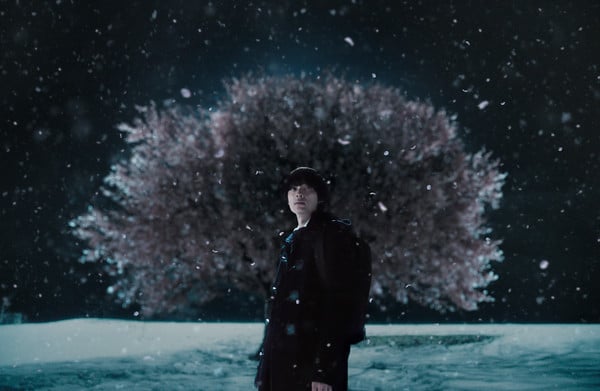Live-Action Film Director Yoshiyuki Okuyama on Adapting Makoto Shinkai's Classic 5 Centimeters Per Second Anime
by Blake Simons,
You're a relatively young filmmaker – you must have been in your teens when Shinkai's original film came out. Did you first encounter the film on its initial release? What did you think of it, and did it resonate with you?
Yoshiyuki Okuyama: I didn't see the film in theatres – my first time watching it was on DVD when I was in high school. The film delved into the innermost parts of Takaki's character and depicted something that felt universal. It was refreshing for me to see something where micro and macro coexist. It was also very refreshing to see animation depicting a place that exists in the real world – I had always thought that animation draws a fictional world.
It's perhaps a given with a live-action film that it will end up having a more realist feel, but your approach here is more grounded and emotionally truthful than the original. Were you conscious of fleshing out Takaki's uncomfortable emotions and the sadness that underpins them when adapting this work?
OKUYAMA: When the original version came out, the audience felt that the film had a very sad ending. Compared to the animation, I think that this live-action version concludes the narrative with a more positive sentiment.
We brought more detail to how Takaki is losing his grip on his emotions while he is getting swamped with work. In the original, this was a montage. So we added more detail to the parts that hadn't been fully drawn in the animation.
I was conscious of the things that can only be done in live-action, the importance of live-action adaptation. In animation, you can't move characters unless you draw them moving. In live-action, on the other hand, we can capture the actors' unconscious movements and the subtleties of their expressions. Regarding a realist feel, we were mindful of the impact of the way that actors say their lines, and their body language – even if those are not written in the script.

Your actors really capture and embody their unspoken feelings. It's one thing to create a chemistry between your actors – here you manage to bring out performances that truly let us see inside the characters' heads and sense what they don't say out loud. How did you go about directing your actors to achieve this?
OKUYAMA: I indeed believe that we were able to achieve something that makes the live-action adaptation fascinating – to convey things without words, instead through expression and movement. To emphasize that, we decided to cut down the monologues compared to the original version. In filming, we used many long takes. Rather than cutting to a new take for each word, we were mindful to film from the beginning to the end of each scene so we could incorporate the unpredictability of live-action.
It's just like a chemical reaction. In acting, when there are multiple actors, what one actor expresses affects the others, creating a chain reaction. We were also mindful to keep the on-set crew small. We wanted the perspective of the actor and the perspective of the character they played to become one, allowing the actors to immerse themselves in their roles – so we didn't want them to be surrounded by numerous camera and lighting crews.
The film has an attractive film grain look to it. Was it shot on film or digital?
OKUYAMA: We filmed it digitally, but we used film recording (filming out) and transferred it to 16mm film.
The original work has an episodic, fragmented style, which would seem a good fit with you, given that your first feature, At the Bench, had a similar structure, and you have experience in music video filmmaking. Was that history why you came to be involved in this project? Did you originate this adaptation idea, or was it brought to you?
OKUYAMA: A producer on 5 Centimeters (2025), Tamai-san, offered me this project after seeing At the Bench.

This film is twice the length of the original anime. How did you and writer Suzuki-san work to expand it?
OKUYAMA: We had many meetings throughout the year – four to five hours every one to two weeks. I was always mindful of expressing things through facial expressions and movement where possible, rather than using monologues.
The original work is structured like a collection of short stories, but in the live-action adaptation, we present the life of Takaki Tono as a continuous line, with a continuous flow. By presenting it in a continuous flow, we thought it would allow the audience's emotions to flow continuously also. Many new motifs and characters in this film did not appear in the original version, like the Voyager's Golden Record or the owner of the planetarium. We are also putting more details on a character named Midori. Across the three phases of his life – childhood, high school, and adulthood – Takaki reconnects with the words he cherishes, the scenes, and the times he shared with his important people. These memories resonate with him as if he were meeting them anew, allowing him to notice something he may have overlooked before. That is the point that I think we managed to expand in this live-action version.
Has director Shinkai seen the film? What did he think of it?
OKUYAMA: He has, and he told us that he was impressed. He said he cried, but he did not understand what he was crying for. When you watch this film, a genuine emotion from your heart will transcend any reason or logic. I was thrilled that we were able to create a film that evoked such strong emotions in the audience. He also said the film is populated with character portrayals that cannot be achieved in animation, and he strongly felt the significance of the live-action adaptation.
This film reminded me less of Shinkai's original work and more of the work of filmmakers such as Shunji Iwai and Hideaki Anno. Were either of these filmmakers influential on your approach here?
OKUYAMA: To be honest, I have not seen many films from them. I didn't grow up watching Japanese films, so I was not familiar with the filmmaking styles of Iwai or Anno. Other filmmakers influenced my approach more. For this film in particular, the angles and the placement of characters were influenced by Celine Song's Past Lives. The way facial expressions convey things was influenced by Charlotte Wells' Aftersun, and the feeling left after Sofia Coppola's Somewhere influenced the cinematic experience.
I actually thought of Past Lives when watching this film, so it's rewarding to hear that.
OKUYAMA: The way we shoot a character from left or right, or the placement of a character – whether on the left or right when two people are standing – can reflect whether they are thinking about the past, or looking toward the future. That is something that I was deeply influenced by from Past Lives. And Celine Song herself was also influenced by Akira Kurosawa's High and Low. So I'm glad that you could see the inspiration.

Tell me about casting. Your lead, Hokuto Matsumura, had a connection to Shinkai's films already, as he voiced one of the leads in Suzume.
Matsumura is an actor whom Shinkai deeply trusts. When I met him for the first time, I saw Takaki in his personality. The way he communicates with others while contemplating. The way he communicates with others while also communicating with himself. His personality involves hesitation and wavering. I found it fascinating. This anxiety and impatience are essentially human. Now I strongly feel that he was the only one who could play Takaki.
Romantic dramas are arguably an oversaturated genre in Japanese cinema. Were you conscious of bringing a different approach to the genre?
OKUYAMA: I didn't grow up watching Japanese romantic drama films at all, so I wasn't really conscious of bringing a different approach, to be honest. In this film, the theme of romance is just a part of a broader narrative depicting one man's life. There is the pureness of childhood, the straightforwardness of youth, and the anxiety of becoming an adult. This film depicts something universal, and the romantic emotion is a part of that.
There is one thing we were mindful of, and that is the relationship between Takaki and Akari. The original version emphasizes their romantic relationship. However, in this film, we depicted them as soulmates who give each other comfort, allowing the audience to see it as more than just a romantic relationship. If the producer offered this project to me just to make a simple romantic drama, I don't think I would be the right choice. But it seems that he also wanted to make a film about a life, so it worked out in the end.
It strikes me that – with this film and your music video for Yonezu Kenshi's "Kick Back" – you're experienced in taking elements that we associate with anime and bringing them closer to our real world through live-action. What do you think we can gain as spectators and human beings by bringing anime worlds and narratives closer to our own realities?
OKUYAMA: I find it realistic when reality and fiction coexist. That comes from my childhood, when I spent a lot of time imagining things in my head rather than talking with others. Therefore, things I saw in real life and things I imagined in my head carried the same weight and value for me. My perception of the world floats just a few millimeters above reality, and I think that is why my projects are seen as having a quality akin to animation.
What did making this film do for you as a person? – whether that's something you thought or felt within yourself, having made the film, a realization, anything at all.
OKUYAMA: When I received the offer for this project, I was experiencing a similar feeling to Takaki. It's something unique to being in your early 30s – a feeling of insufficiency about how I will live my future. I felt like I was covered by a layer of film. However, through the production process, I felt as though the fog had lifted, and I could take a step forward. That was because we made this film as a team. I communicated with different people and interacted with different views and ideas. Rather than being in a spiral of self-reflection, the time we spent pursuing the best solutions together made me a little more positive.
What would you like your audiences to take away from watching this film?
OKUYAMA: Every audience member has troubles and worries in their daily lives. Even when they're watching a film, those troubles and worries are spiralling in a corner of their head. I want this film to put a hand on their back and say, “It's okay.” I think the city looks different after watching this film.
With thanks to Yuki Fujiwara for translating.
5 Centimeters per Second opens in Japan on October 10 with additional screenings planned in Vietnam, Thailand, and Indonesia.
discuss this in the forum (1 post) |
this article has been modified since it was originally posted; see change history